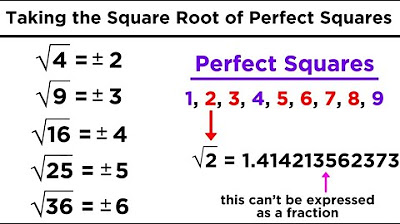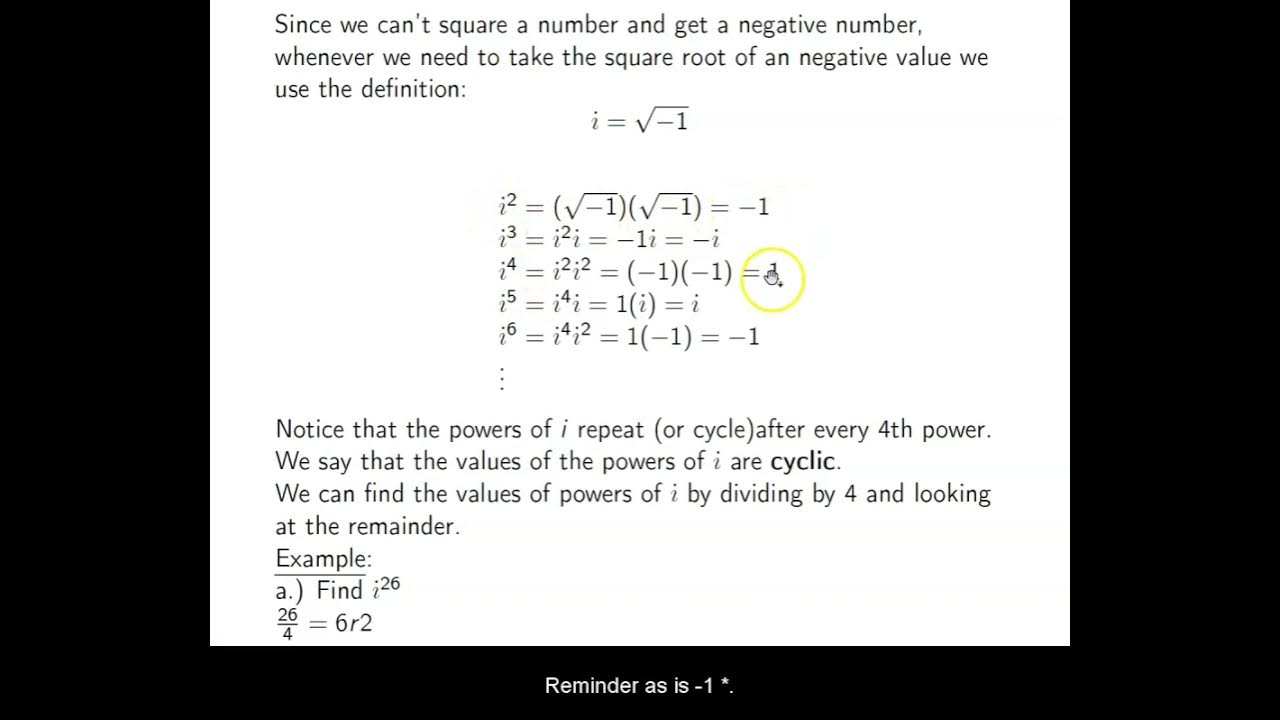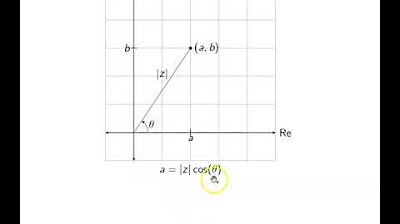Exponential form to find complex roots | Imaginary and complex numbers | Precalculus | Khan Academy
TLDRThis video script delves into the utility of exponential form for complex numbers, particularly when solving equations like x^3 = 1 for all real and complex roots. It illustrates the process using the exponential representation of 1, explaining how to find cube roots through Argand diagrams and the significance of the argument of a complex number. The script demonstrates solving for x by taking the cube root of different forms of 1, revealing three distinct roots including the real number 1 and two complex numbers. It visually represents these roots on the complex plane, explains their magnitudes and arguments, and converts them into the form a + bi. The technique is applicable to finding roots of higher degrees and showcases the pattern of roots distribution.
Takeaways
- 🔢 The video aims to demonstrate the usefulness of the exponential form of a complex number.
- 🧩 The equation x^3 = 1 is analyzed to find all real and complex roots.
- 🧮 The exponential form technique is versatile and can be applied to equations like x^5 - 1 or x^13 - 1.
- 📉 The exponential representation of 1 is explored on an Argand diagram.
- 🌀 The magnitude of z (where z = 1) is 1, and its argument is 0 radians or any multiple of 2π.
- 📐 The video shows how 1 can be expressed as e^(2πi), e^(4πi), etc., and why this is useful.
- 🧠 By taking the one-third power of these exponential forms, we find the roots of the equation.
- 📏 The three roots of the equation x^3 = 1 are 1, e^(2πi/3), and e^(4πi/3).
- 🌐 These roots are visualized on the Argand diagram, showing their arguments as angles in radians.
- 📝 The video explains how to convert these exponential forms to the a + bi format, finding their real and imaginary parts.
- 🔍 The method can be extended to find higher-order roots (e.g., fourth roots), and the patterns of roots are discussed.
Q & A
What is the main topic of the video?
-The main topic of the video is to explain why the exponential form of a complex number is useful, particularly in solving equations like x^3 = 1 for all real and complex roots.
What equation does the video start with as an example?
-The video starts with the equation x^3 = 1 as an example to find all the real and complex roots.
How does the video suggest to represent the complex number 1?
-The video suggests representing the complex number 1 in exponential form as 1 * e^(0i), where the magnitude is 1 and the argument is 0 radians.
What is an alternative argument for the complex number 1 in exponential form?
-An alternative argument for the complex number 1 in exponential form can be 2πi, 4πi, 6πi, etc., since adding multiples of 2π to the argument brings you to the same point on the complex plane.
Why is the argument of a complex number important in the context of this video?
-The argument of a complex number is important because it allows for the representation of the same complex number in multiple ways, which is useful for solving equations and visualizing roots on an Argand diagram.
How does taking the cube root of a complex number relate to dividing the circle or angle?
-Taking the cube root of a complex number relates to dividing the circle or angle into three equal parts, each representing a different root of the original number.
What are the three cube roots of 1 found in the video?
-The three cube roots of 1 found in the video are 1, e^(2πi/3), and e^(4πi/3), which correspond to 1, a complex number with an argument of 120 degrees, and another complex number with an argument of 240 degrees, respectively.
How does the video explain converting the exponential form of a complex number to the rectangular form?
-The video explains converting the exponential form to the rectangular form by using the cosine and sine of the argument, for example, x2 = cos(2π/3) + i * sin(2π/3).
What is the significance of the number e in the context of complex numbers in this video?
-In the context of complex numbers, the number e is significant as the base of the exponential function used to represent complex numbers in exponential form, allowing for a powerful and flexible way to work with roots and arguments.
How does the video demonstrate the pattern of roots on an Argand diagram?
-The video demonstrates the pattern of roots on an Argand diagram by showing that the cube roots of 1 are evenly spaced around the unit circle at 120-degree intervals, corresponding to the arguments of their exponential forms.
Why does the video stop at e^(4πi) when finding roots?
-The video stops at e^(4πi) because beyond this point, adding multiples of 2π to the argument will only yield the same roots found already, making further search redundant when finding the third roots of a number.
Outlines
🔍 Introduction to Exponential Form of Complex Numbers
The video begins by introducing the concept of the exponential form of complex numbers and its utility. The presenter aims to solve the equation x^3 = 1 to find all real and complex roots. This is equivalent to x^3 - 1 = 0. The method discussed can be applied to similar equations with different exponents and will reveal patterns on an Argand diagram. The presenter starts by considering the exponential form of the complex number 1, which is a real number with no imaginary part. The Argand diagram is used to visualize this, with the real axis and imaginary axis defined. The complex number 1 is represented as a vector pointing to (1,0) on the Argand diagram. The exponential form is then introduced, with the magnitude being 1 and the argument being 0 radians, which can also be expressed as any multiple of 2π radians due to the periodic nature of the exponential function.
📚 Finding Roots Using Exponential Form
The presenter continues by demonstrating how to find the roots of the equation x^3 = 1 using the exponential form. By recognizing that 1 can be represented as e^(0i), e^(2πi), e^(4πi), and so on, the equation can be rewritten in multiple ways. Taking the cube root of both sides of these equations yields three different roots: x = 1, x = e^(2πi/3), and x = e^(4πi/3). These roots are then visualized on the Argand diagram, showing that they all have a magnitude of 1 but different arguments. The roots are labeled as x1, x2, and x3, with x1 being 1, x2 having an argument of 2π/3 (or 120 degrees), and x3 having an argument of 4π/3 (or 240 degrees). The presenter explains that these roots represent rotations of the original number 1 on the Argand diagram.
🌐 Visualizing and Converting Complex Roots
The video script then delves into visualizing the complex roots x2 and x3 on the Argand diagram. The argument of x2 is 2π/3, placing it at an angle of 120 degrees from the positive real axis. Similarly, x3 has an argument of 4π/3, corresponding to an angle of 240 degrees. The magnitude of both x2 and x3 is 1, indicating they lie on the unit circle. To further clarify, the presenter converts these complex roots into the form a + bi, using trigonometric functions. For x2, this results in -1/2 + (√3/2)i, and for x3, it is -1/2 - (√3/2)i. The process demonstrates how the cube roots of the real number 1 are distributed evenly around the unit circle, each separated by 120 degrees. The presenter also touches on the generalization of this technique to find higher order roots, such as the fourth and eighth roots of 1, and explains why only three unique roots exist for the cube roots of a number.
Mindmap
Keywords
💡Exponential Form
💡Complex Number
💡Argand Diagram
💡Magnitude
💡Argument
💡Euler's Formula
💡Roots of Unity
💡Cosine and Sine
💡Radians
💡Cube Roots
Highlights
The video explains why the exponential form of a complex number is useful.
Solves the equation x^3 = 1 to find all real and complex roots.
Technique can be applied to equations like x^5 - 1 = 0 or x^13 - 1 = 0.
Introduces patterns that emerge on an Argand diagram.
Exponential representation of 1 is discussed.
All real numbers are a subset of complex numbers.
Magnitude and argument of z are explained.
Argument of 1 can be 0 radians or multiples of 2π.
Equation x^3 = 1 can be rewritten in multiple exponential forms.
Taking the cube root of 1 in different forms.
Finding the cube roots: 1, e^(2πi/3), and e^(4πi/3).
Visualization of complex roots on the Argand diagram.
Root x1 is 1, a real number.
Root x2 is a complex number with an argument of 2π/3.
Root x3 is a complex number with an argument of 4π/3.
Conversion of exponential form to a + bi form.
x2 is expressed as cos(2π/3) + i*sin(2π/3).
x3 is expressed as -1/2 - sqrt(3)/2i.
Technique can be used to find fourth roots of 1.
Explains why only three roots are found for cube roots.
Transcripts
Browse More Related Video

Basic complex analysis | Imaginary and complex numbers | Precalculus | Khan Academy

Complex Numbers: Operations, Complex Conjugates, and the Linear Factorization Theorem

Square Roots, Cube Roots, and Other Roots

Add, Subtract, Multiply, Divide Imaginary & Complex Numbers - [1]

Ch. 1.6 Complex Numbers

Ch. 8.3 Polar Form of Complex Numbers and DeMoivre's Theorem
5.0 / 5 (0 votes)
Thanks for rating: